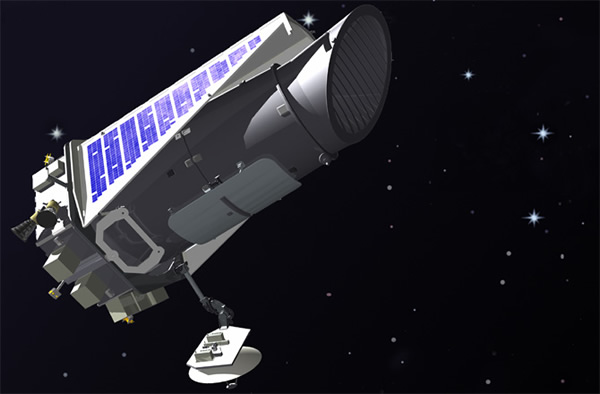Kepler's Planet-Hunting Mission May Be Over
NASA’s planet-hunting Kepler space telescope has shut down due to an apparent problem with its positioning system, suspending indefinitely its science mission, officials said Wednesday.
So far, attempts to coax the telescope back into operation have been fruitless. Two of the observatory’s four spinning reaction wheels, needed to properly point Kepler at its targets, are now no longer working.
As designed, the telescope needs at least three of its four wheels spinning to steady itself for the delicate task of finding planets circling distant stars.
“We need three wheels in service to give us the pointing precision that is necessary to find planets,” Kepler lead scientist William Borucki, with NASA’s Ames Research Center in California, told reporters on a conference call Wednesday.
Artist's impression of the Kepler space telescope.
Kepler, which was launched in 2009, lost its first positioning wheel last year.
“People are definitely saddened by the loss of another reaction wheel. It certainly is not good news for the mission, which has been performing so well and had so much promise for doing even better,” deputy project manager Charles Sobeck, with the Ames Research Center, told Discovery News.
Kepler works by detecting slight dips in the amount of starlight coming from about 100,000 target stars in the constellations Cygnus and Lyra. Follow-up observations and analysis then determine if the dips are caused by planets passing in front of their parent stars, relative to the telescope’s point of view, or other phenomena.
So far, Kepler scientists have found and confirmed 130 extrasolar planets, and are in the process of assessing another 2,700 potential candidates.
The goal of the mission is to find Earth-sized planets positioned at the right distance from their parent stars for liquid water to exist on their surfaces. Liquid water is believed to be necessary for life.
Though the telescope currently isn’t collecting any data, scientists have years of archived observations to analyze.
“Frankly, I’m absolutely delighted that we’ve got all this data, that we have been so successful, that we have found so many thousands of planetary candidates,” Borucki told Discovery News.
“The mission was designed for four years, it operated four years. It gave us excellent data for four years. So I’m very delighted,” he said.
“On the other hand I would have been even happier if it continued another four years because we’d have better data about more stars, about smaller planets and we’d have more planets that we’d probably find in the habitable zone, so that would have been in some sense frosting on the cake, but we have an excellent cake right now.”
In addition to trying to resurrect Kepler’s failed wheel, engineers and scientists will be assessing if the telescope, which still has fuel for maneuvering, can be put to use for other astronomical studies.(May 15, 2013 05:51 PM ET // by Irene Klotz)












